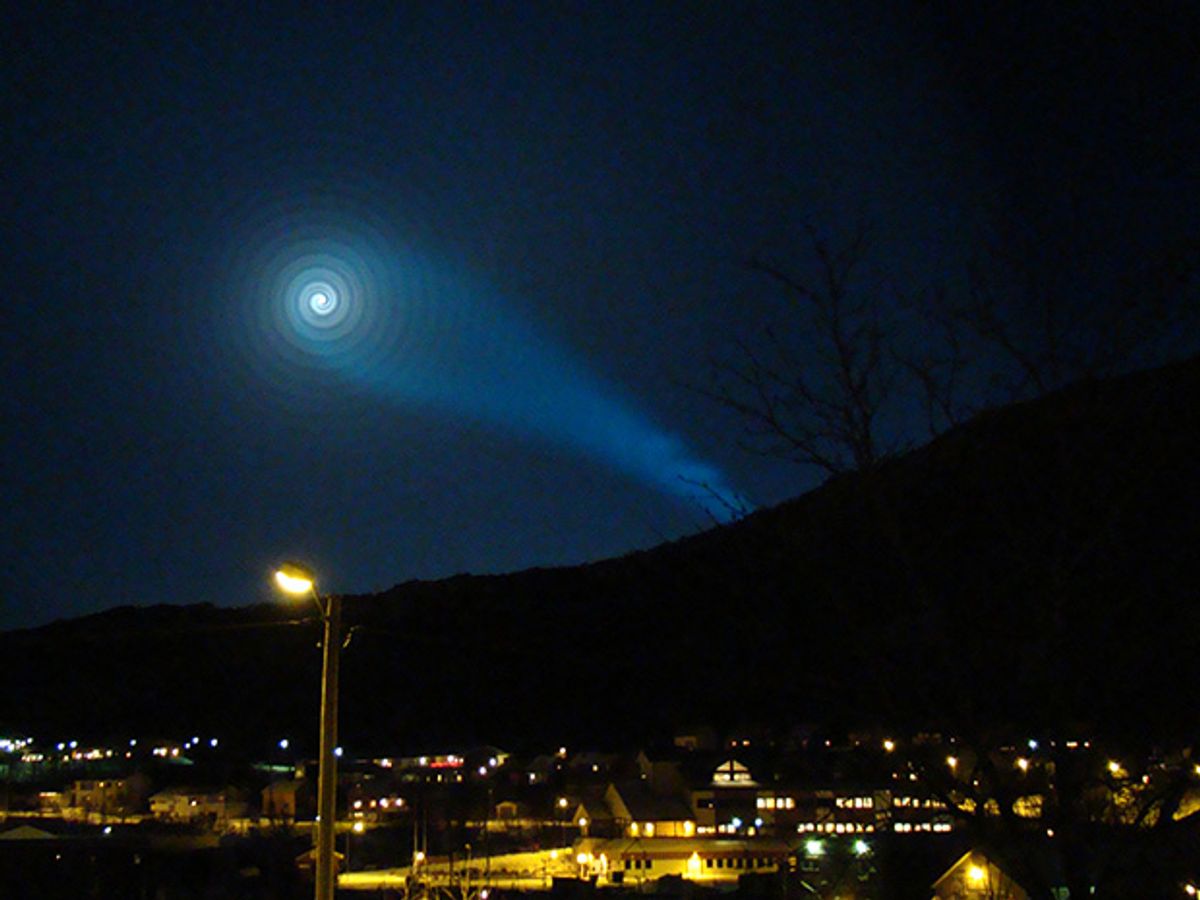One of the most spectacular sky shows in recent history took place shortly before dawn this past 9 December over northern Norway. Hundreds of witnesses—many of them fortuitously equipped with the latest in camcorder technology—stared in amazement at a bright white spiral cloud spinning silently in the eastern sky.
Before being identified as what it was—a Russian military missile test—the apparition was variously hailed a UFO, a cosmic wormhole, a divine vision, a mishap caused by the newly operational Large Hadron Collider, and some nefarious ionospheric engineering by the notorious High Frequency Active Auroral Research Program antennas.
At the Russian Ministry of Defense, in Moscow, one could easily forgive officials for wishing that one of those explanations were correct. That's because the reality was a glaring advertisement for what has become the greatest aerospace engineering crisis of the Russian government: the disaster-ridden (“trouble-plagued" would be an understatement) military missile called Bulava [accent on the middle syllable]. Designed to be the next-generation submarine-launched intercontinental ballistic missile (ICBM), Bulava has had 11 test flights since 2005—and has failed most of them, including the last three in a row.
For more than a full day after the Norway “sky spiral," major Moscow news media ignored any connection with a Russian missile. The few remaining independent papers were the first to recapitulate the lamentable story of the Bulava. Finally, about 26 hours after the failed launch, an official press release admitted that a “technical malfunction" in the third stage of the missile had led to the failure of its test flight.
Beyond the threat to Russia's nuclear deterrent, the problems with the missile have become a major scandal for the Putin/Medvedev government. Hard-line Communist Party critics accuse them of letting the entire Russian military industrial complex decay to the point of danger. (Russian aircraft, communications, and navigation equipment performed poorly in the brief Russia-Georgia War, in late 2008.) “Russia's technological potential has been totally destroyed by the reformers," complained ardent nationalist Captain Konstantin Sivkov in an interview last October with the Svobodnaya Pressa [Free Press] Web site. Critics are also looking more closely at how the troubled missile project got started in the first place and whether there were bribes involved.
In 1998, as economic collapse was starving most post-Soviet defense industries, a firm named the Moscow Institute of Thermal Technology won a contract to provide the next-generation submarine-based solid-fuel nuclear missile, beating out the experienced Makeyev Design Bureau, whose prototype R-39 Bark missile had suffered three test failures. The new firm, which had never built submarine-launched missiles before, proposed adapting its existing ground-based ICBM (the solid-fuel RS-12M Topol) to underwater launch mode.
Supposedly because that missile was already in use on land was already proved out, the Bulava program (R-30 is its official name) skipped extensive intermediate testing at ground facilities and even tests normally conducted in a large water tank that simulates sea-based launches. It proceeded directly to sea trials, and the first three simplified tests achieved their objectives.
After more-realistic, full-range tests began, the program imploded. One launch after the next failed—and most discouragingly, in different ways. “Each accident takes place for different reasons, and there is no end to them," wrote independent military commentator Viktor Myasnikov the day after the latest failure. “Elimination of the most recent 'weak spot' only leads to the appearance of the next one."
By mid-2009, the program looked doomed. The missile's top designer, Yury Solomonov, resigned, and the military officer in charge of all Russian military missiles retired. Special review panels were formed from experienced space and rocket experts at the Russian Academy of Sciences and the Russian Federal Space Agency, which, though nominally civilian, has long been in charge of developing all long-range Russian military missiles.
Already, three giant nuclear-powered missile submarines have been constructed specifically to carry the Bulava, with its six to eight independently targeted 150-kiloton warheads. Desperate planning to come up with backup missile designs has not yielded results—the subs can carry only Bulava-like missiles.
Even before the latest failure, Russian military industry experts had been speculating about systemic weaknesses behind the problems. Two weeks before the spiral failure over Norway, Sergey Kovalev, a designer of missile submarine at the Rubin Design Bureau, in Saint Petersburg, told a reporter for the weekly Argumenti i Fakti [Arguments and Facts] that for many components of Bulava, well-tested standard equipment had been replaced with new and untried products. “The Bulava is built with much more modern materials and a different component base" than the Topol, the missile on which it was supposed to be based, he said.
Igor Korotchenko, editor in chief of the trade journal Natsionalnaya Oborona [National Defense], pointed to the industrial base as the culprit. “A portion of the components are seriously defective," he wrote. General Vladimir Popovkin, deputy defense minister for acquisitions, also blamed the manufacturers of critical components for sloppy work in an interview in the newspaper Vremya Novostey.
Kovalev, in his interview in Argumenti i Fakti, agreed. 'One of the reasons for the failed Bulava launches is unsuitable metal piping," he said. “[This was] because the plant, which earlier had manufactured it in accordance with state standards, now sets its own norms, which allows various deviations. Poor-quality work in the race for money. The piping leaked, and the missile blew up." Kovalev said that shoddy materials like that wouldn't have been tolerated under the Soviet regime, and he predicted that more such stories would come to light in future test flights.
The next test flight is now planned for sometime in June, with the eyes of the Russian defense industry focused on it. UFO watchers in Norway and Finland should keep their camcorders handy as well.
